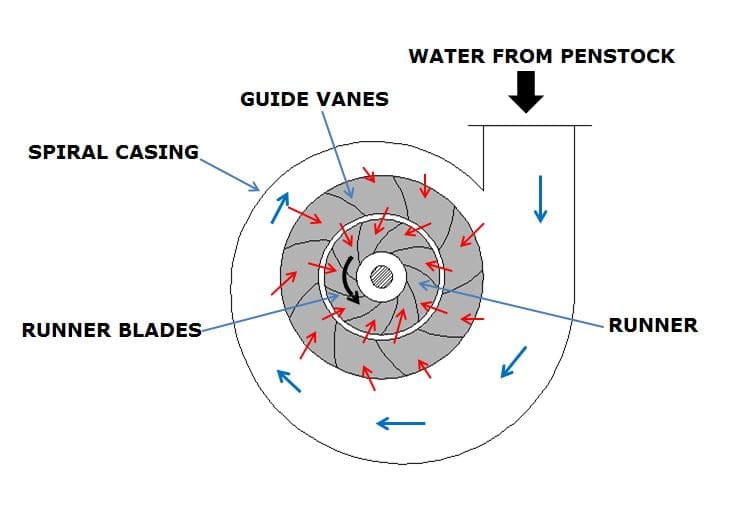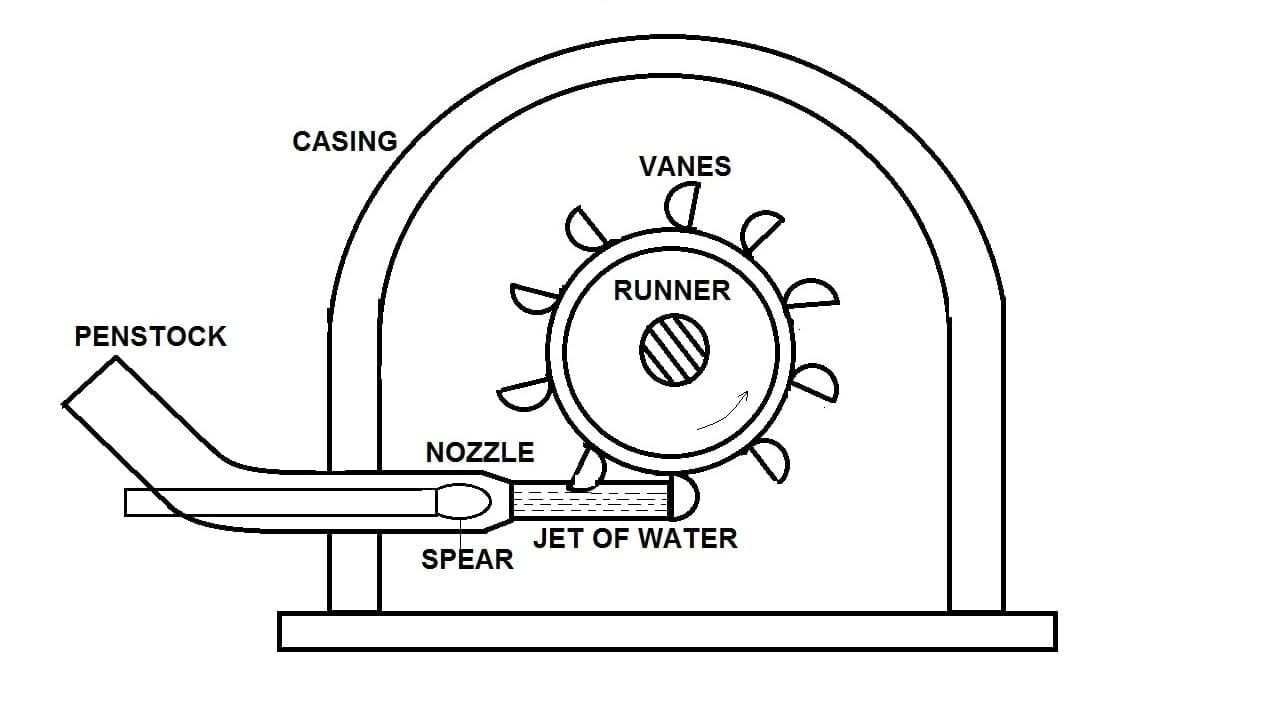Hey readers, In the last article we have studied Pelton Wheel Turbine. Now we will look at Kaplan Turbine and its various terms like Definition, Construction or Parts, Working Principle, Application, Advantages, Disadvantages, and at last PDF.
Let’s start with the definition first,
Kaplan Turbine Definition:
Kaplan Turbine was developed in 1913 by Viktor Kaplan (Austrian Professor). Kaplan Turbine is a type of reaction turbine which works is to produce electrical energy and it is used for high discharge and low heads.
Various aspects of Kaplan Turbine are:
- This is a low head, high discharge reaction turbine.
- It is an axial flow turbine not mixed or radial. Its blades are adjustable i.e pitch of blades, blade inlet, and outlet angle are adjusted according to varied discharge and head.
- This adjustment is done for maximum efficiency over wide operating conditions.
Since the flow of fluid in the Kaplan turbine is axial, the number of blades in Kaplan is 3 to 6 as compared to 16 to 24 in another turbine, So less contact surface and fewer friction losses.
Now coming to construction,
Kaplan Turbine Construction or Main Parts:
Kaplan Turbine consists of following main parts:
- Turbine Shaft
- Guide Vane
- Runner Vanes
- Scroll Casing
- Draft Tube
- Tail Race

Lets study working one by one in detail.
Turbine Shaft:
This is an important component that is used for rotating the motor to generated electricity. In the runner blades, the turbine shafts are attached.
When the runner blades rotate the turbine shafts also rotate which helps to generate electrical energy.
Turbine Shaft must have heat-resistant properties because it rotates at a high speed of 1800-3600 rpm. The turbine shaft material is structural steel and others.
Guide Vane:
Guide vanes act as a control gate that means It is regulating the flow of water depending on the requirement.
When guide vanes open full then there is a maximum flow of water and it strikes the turbine blades hence more energy can be generated.
When guide vanes open half therefore the flow rate of water is low comparatively. So less water strikes with low force on the turbine blades hence less generation of electricity.
Runner Vanes:
This is an important part of this turbine. The blades are attached to the runner.
From the runner, the shaft is attached and connected with the generator. When the runner rotates, the shaft also rotates.
Scroll Casing:
The scroll casing is a special type of casing that decreases the cross-sectional area as you can see in the diagram and scroll casing is the upper part of the turbine which helps to protect the runner, runner blades, and so on.
The water is entered into the scroll casing via penstock and then the water flows to the guide vanes. Now from here, the water comes at the runner.
Draft Tube:
Draft Tube is used in the reaction turbine and it is similar to pipe but on one side has a long cross-sectional area.
Draft Tube increases the pressure of the fluid. The water can not send directly to the tailrace therefore this tube has been inserted. It works is to discharge the water from the tailrace.
There are four different types of Draft tube:
- Simple Elbow,
- Elbow with the varying cross-section,
- Moody Spreading and,
- Conical Diffuser or Divergent Draft Tube.
Tail Race:
In simple the tail race is used to release the water which is already used for the rotation of the runner blades or turbine blades.
Now lets study working of Kaplan turbine,
Kaplan Turbine Working Principle:
The head at the inlet of the turbine is the sum of pressure and kinetic energy and during the flow of water through the runner, a part of the pressure energy is converted into kinetic energy the turbine.
The shaft of an axial flow reaction turbine is vertical, the lower end of the shaft is made larger which known as a hub or boss.
The vanes are fixed on the hub and it is acting runner But the water enters the runners in an axial direction and leaves axially.
The pressure at the inlet of the blades is larger than the pressure at the exit of the blades. The energy transfer is due to the reaction effect, i.e the change in the magnitude of relative velocity across the blades.
Now lets study how it is working,
The water is entered into the spiral casing of the turine. The turbine shafts conncted with runner blades or turbine blades. The water comes to the guide vanes. Guide vane is like controlling the flow of water. Now if it opens the water strikes the runner baldes.
The runner strats rotating due to this turibe shaft also rotates. The turbine shafts is connected to the generator for electric generation.
The water which is used for rotating the runner blades now will come to draft tube. And from Draft tube the water goes to tail race and to the river.
Here you can watch the video of Kaplan Turbine:
Kaplan Turbine Advantages:
The following advantages of Kaplan Turbine are:
- The Kaplan Turbine is used for the low head.
- The size of this turbine is not large.
- Therefore Space requirement is also low because of limited size.
- It can be used for high discharge applications.
- A very high specific speed can be obtained.
- There can be less loss of efficiency at part loads.
Kaplan Turbine Disadvantages:
The following disadvantages of Kaplan Turbine are:
- The maintenance cost is high.
- There is cavitation that occurs when the pressure drops at the draft tube. To overcome this problem we can use stainless steel for pipe material and so on.
- The generator chamber got water leakage and there can be troublesome due to condensation.
Kaplan Turbine Application:
The following application of Kaplan Turbine are:
- The main application of the Kaplan Turbine is in Hydro electrical power production.
- The Kaplan turbine is smaller in size and construction is also easy.
- At low water heads, the Kaplan turbine works more efficiently and with high flow rates compared to other types of turbines.
- The overall efficiency of this turbine is good.
Related article:
Venturimeter
Orifice Meter
Francis Turbine
So that’s all for Kaplan Turbine. Let me know what other topic you are looking for to discuss?. Till then you can read our other articles. And do not forget to share with your colleague. Good Luck.



![Different Types of Measuring Tools and their Uses [Notes & PDF] Feature Image of Types of Measuring Tools](https://themechanicalengineering.com/wp-content/uploads/2023/01/Feature-Image-of-Types-of-Measuring-Tools-300x171.jpg)
![Steel: Properties, Different Types and Applications [Notes & PDF] Feature Image of Steel](https://themechanicalengineering.com/wp-content/uploads/2023/01/Feature-Image-of-Steel-300x168.jpg)






Discussion about this post